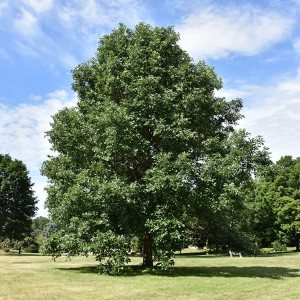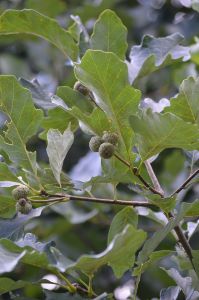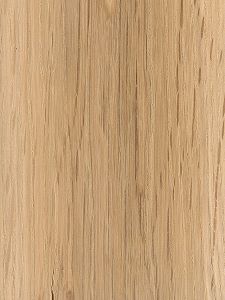Swamp white oak
Description
Swamp white oak, Quercus bicolor Willd, is a part of the oak subgroup within the Beech family. [3] It is a perennial dicot within the oak subgroup. It is a slow growing tree that is often planted by people along sites with poor drainage or along sidewalks, roads, and walkways to provide shade.
Taxonomy

| |
| Kingdom: | Plantae |
|---|---|
| Phylum: | Tracheobionta (Vascular plants) |
| Class: | Magnoliophyta |
| Order: | Anura |
| Family: | Fagales |
| Genus: | Quercus L. (Oak) |
| Species: | Quercus bicolor Willd. (Swamp white oak) |
| Source: Integrated Taxonomic Information System [1] | |
Conservation Status
Swamp white oak is listed as Least Concern. [1]
Identification
Swamp white oak is typically between 15 to 30 meters tall. Its bark is typically dark grey, scaly, and peels off in scales. Its leaves grow in an alternate leaf pattern, the leaf shapes are obovate, and have crenate edges. The underside of the leaves are white during the spring, and in the fall, the leaves turn into different shades of red.[7] The branches are alternate, and, when flowering, contain relatively small buds for an oak tree.[4] Their shape when mature is rounded and broad, creating a thick canopy. [5]


Habitat and Distribution
Swamp white oak is native to some of Midwestern United States, the eastern side the United States and Canada. Swamp white oak trees can be found as far south as South Carolina and as far north as Northern Quebec. These trees are abundant. [2] It grows in silty clay, silt, and sandy loam soil ecosystems. They do well in wet to moist, sunny, acidic soil ecosystems. They are usually found at elevations from 0 to 1000 meters. [3][5]
Uses
The wood of the Swamp white oak is sold as lumber, but is not seen as having a high value. It is often used for cheap furniture, crates, fences, and other things used in general construction as it is cheap and a relatively hard wood. Often, it is used in recreational areas as shade. Its acorns, although they contain tannic acid, can be eaten by humans and animals alike and have been eaten for hundreds of years. [3]

Sources
[1]Kenny, L., Wenzell, K. & Jerome, D. 2017. Quercus bicolor. The IUCN Red List of Threatened Species 2017: e.T194069A111189345. https://dx.doi.org/10.2305/IUCN.UK.2017-2.RLTS.T194069A111189345.en. Accessed on 30 April 2025.
[2] USDA Plants Database. (n.d.). https://plants.usda.gov/plant-profile/QUBI
[3] Mohlenbrock, R. H. (n.d.). SWAMP WHITE OAK. https://plants.usda.gov/DocumentLibrary/plantguide/pdf/pg_qubi.pdf
[4] Swamp white oak. (n.d.). https://ohiodnr.gov/discover-and-learn/plants-trees/broad-leaf-trees/swamp-white-oak-quercus-bicolor
[5] Swamp white oak. (n.d.-b). Natural Resource Stewardship. https://naturalresources.extension.iastate.edu/forestry/iowa_trees/trees/swamp_white_oak.html
[6] Kabrick, J. M., Dey, D. C., Van Sambeek, J. W., Wallendorf, M., & Gold, M. A. (2005). Soil properties and growth of swamp white oak and pin oak on bedded soils in the lower Missouri River floodplain. US Forest Service Research and Development. https://research.fs.usda.gov/treesearch/15686
[7] https://www.beavertonoregon.gov/1258/14-Swamp-White-Oak
- ↑ "Integrated Taxonomic Information System - Report", ITIS USDA Open-File Report 2006-1195: Nomenclature", USDA, n.d.. Retrieved 3/10/2023.